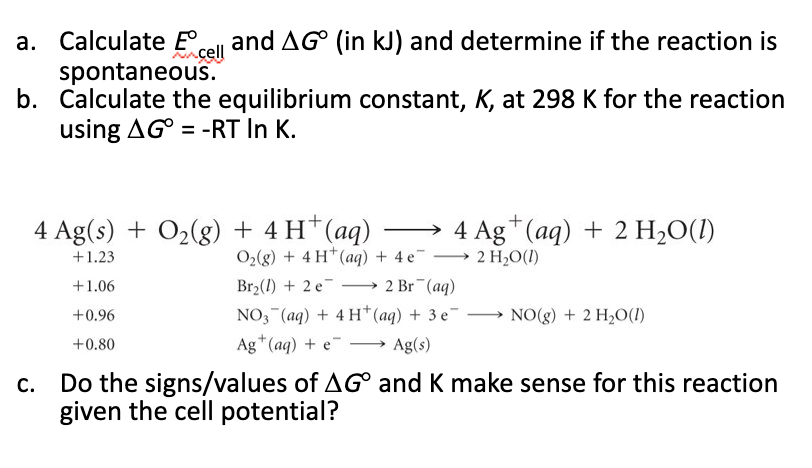a. Calculate Ecell and AG° (in kJ) and determine if the reaction is spontaneous. b. Calculate the equilibrium constant, K, at 298 K for the reaction using AG° = -RT In K. 4 Ag(s) + O2(g) + 4 H*(aq) → 4 Ag*(aq) + 2 H,O(1) O2(g) + 4 H*(aq) + 4 e +1.23 2 H2O(1) - +1.06 Br2(1) + 2 e 2 Br (aq) NO, (aq) + 4 H*(aq) + 3 e¯ Ag*(aq) + e - → NO(g) + 2 H,O(I) +0.96 +0.80 Ag(s) Do the signs/values of AG° and K make sense for this reaction given the cell potential?
a. Calculate Ecell and AG° (in kJ) and determine if the reaction is spontaneous. b. Calculate the equilibrium constant, K, at 298 K for the reaction using AG° = -RT In K. 4 Ag(s) + O2(g) + 4 H*(aq) → 4 Ag*(aq) + 2 H,O(1) O2(g) + 4 H*(aq) + 4 e +1.23 2 H2O(1) - +1.06 Br2(1) + 2 e 2 Br (aq) NO, (aq) + 4 H*(aq) + 3 e¯ Ag*(aq) + e - → NO(g) + 2 H,O(I) +0.96 +0.80 Ag(s) Do the signs/values of AG° and K make sense for this reaction given the cell potential?
Chemistry: Principles and Practice
3rd Edition
ISBN:9780534420123
Author:Daniel L. Reger, Scott R. Goode, David W. Ball, Edward Mercer
Publisher:Daniel L. Reger, Scott R. Goode, David W. Ball, Edward Mercer
Chapter17: Chemcial Thermodynamics
Section: Chapter Questions
Problem 17.59QE: Calculate G for the following reactions and state whether each reaction is spontaneous under...
Related questions
Question

Transcribed Image Text:a. Calculate Ecell and AG° (in kJ) and determine if the reaction is
spontaneous.
b. Calculate the equilibrium constant, K, at 298 K for the reaction
using AG° = -RT In K.
4 Ag(s) + O2(g) + 4 H*(aq) → 4 Ag*(aq) + 2 H,O(1)
O2(g) + 4 H*(aq) + 4 e
+1.23
2 H2O(1)
-
+1.06
Br2(1) + 2 e
2 Br (aq)
NO, (aq) + 4 H*(aq) + 3 e¯
Ag*(aq) + e -
→ NO(g) + 2 H,O(I)
+0.96
+0.80
Ag(s)
Do the signs/values of AG° and K make sense for this reaction
given the cell potential?
Expert Solution
This question has been solved!
Explore an expertly crafted, step-by-step solution for a thorough understanding of key concepts.
This is a popular solution!
Trending now
This is a popular solution!
Step by step
Solved in 6 steps with 11 images

Knowledge Booster
Learn more about
Need a deep-dive on the concept behind this application? Look no further. Learn more about this topic, chemistry and related others by exploring similar questions and additional content below.Recommended textbooks for you

Chemistry: Principles and Practice
Chemistry
ISBN:
9780534420123
Author:
Daniel L. Reger, Scott R. Goode, David W. Ball, Edward Mercer
Publisher:
Cengage Learning

Chemistry by OpenStax (2015-05-04)
Chemistry
ISBN:
9781938168390
Author:
Klaus Theopold, Richard H Langley, Paul Flowers, William R. Robinson, Mark Blaser
Publisher:
OpenStax

Chemistry
Chemistry
ISBN:
9781305957404
Author:
Steven S. Zumdahl, Susan A. Zumdahl, Donald J. DeCoste
Publisher:
Cengage Learning

Chemistry: Principles and Practice
Chemistry
ISBN:
9780534420123
Author:
Daniel L. Reger, Scott R. Goode, David W. Ball, Edward Mercer
Publisher:
Cengage Learning

Chemistry by OpenStax (2015-05-04)
Chemistry
ISBN:
9781938168390
Author:
Klaus Theopold, Richard H Langley, Paul Flowers, William R. Robinson, Mark Blaser
Publisher:
OpenStax

Chemistry
Chemistry
ISBN:
9781305957404
Author:
Steven S. Zumdahl, Susan A. Zumdahl, Donald J. DeCoste
Publisher:
Cengage Learning


Chemistry: An Atoms First Approach
Chemistry
ISBN:
9781305079243
Author:
Steven S. Zumdahl, Susan A. Zumdahl
Publisher:
Cengage Learning

Principles of Modern Chemistry
Chemistry
ISBN:
9781305079113
Author:
David W. Oxtoby, H. Pat Gillis, Laurie J. Butler
Publisher:
Cengage Learning